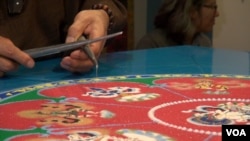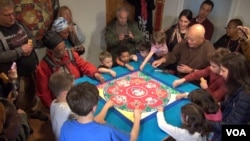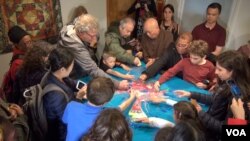The world has more sand than any one of us could ever imagine.
One estimate says there are about seven quintillion, 500 quadrillion particles of sand on Earth. The number is so large that it is nearly uncountable. This makes sand an ideal material for creating spiritual images.
Losang Samten is a Tibetan scholar and former Buddhist monk. He uses colored sand to build circular images called mandalas. Mandalas are filled with complex imagery. They have deep meaning in both Buddhism and Hinduism.
The tradition of making mandalas is about 2,600 years old. Over the centuries, Tibetan monks have made them from different materials. Before sand, they used ground, colored stone.
Now, Samten travels around the world to find different colors of sand. He also uses water-based paints to change the sand’s colors.
Many years of mandalas
Samten is more than 60 years old. He learned the art of mandala-making many years ago from Tibet’s exiled spiritual leader, the Dalai Lama.
“When I was a teenager, age of 17, I had a privilege to enter to His Holiness Dalai Lama’s monastery … in India. I have been studying sand mandalas ever since then. So, it’s a long time.”
VOA found Samten carefully positioning colored sand at the Philadelphia Folklore Project in West Philadelphia, Pennsylvania. He was working on a mandala about unconditional love.
In 1988, Samten created a sand mandala at the American Museum of History in New York at the request of the Dalai Lama. It was the first time the art form was seen outside of a monastery. Since then, Samten has made sand mandalas at museums, art galleries and universities across the United States and many parts of the world.
“They are used to enhance the spiritual practice through image and meditation, to overcome suffering. Mandalas represent enlightened qualities and methods which explain this path, making them very important for the spiritual journey,” Samten wrote on his website.
Nothing is permanent
Samten was born in Tibet. When he was a boy, his family escaped to Nepal, fleeing Chinese Communist control of his homeland. They lived in a refugee camp for years.
“The winter of 1959, [we] crossed Mount Everest, it took us two months to cross. You cannot travel during the day and so scared and not enough food, not enough clothes. I was age of 5. I saw, I mean unbelievable dead bodies, people dying without food. I become a monk at age 11, when I was in school, refugee school.”
Samten left monastic life in 1995 and became the spiritual director at the Tibetan Buddhist Center of Philadelphia. He says the patience of the creative process can lead observers to find peace and strength within themselves.
“When I am doing this mandala at the universities and the schools, many kids came to me, (saying) ‘when I saw you doing the sand mandala, that help me so much to finish my education, patience ...’ Well, I have a lot of stories.”
Beauty comes and goes
After a sand mandala is completed, it is destroyed as part of a ceremony. Samten says there are many reasons for this. One reason is for beauty.
“Whatever we see as a beauty on the earth, never be everlasting as a beauty and impermanent, impermanent, comes and goes.”
Samten often invites children to take part in the ceremony.
To visitor Traci Chiodress, that was part of the magnetism of the event.
“I think it’s powerful to see something so beautiful created, and then taken apart, and to be done in a community with a group of people of different ages,” she said. “I just think it’s an important type of practice.”
I’m Alice Bryant.
June Soh wrote this story for VOA News. Alice Bryant adapted her story for Learning English. George Grow was the editor.
_______________________________________________________________
Words in This Story
quintillion – n. a million raised to the power of 5
quadrillion – n. a thousand raised to the power of 5
scholar – n. a person who has studied a subject for a long time and knows a lot about it
monk – n. a member of a religious community of men who usually promise to remain poor, unmarried, and separated from the rest of society
privilege – n. a right or benefit that is given to some people and not to others
monastery – n. a place where monks live and work together
meditation – n. the act or process of spending time in quiet thought
journey – n. an act of traveling from one place to another
scared – adj. afraid of something
kid – n. a young person







